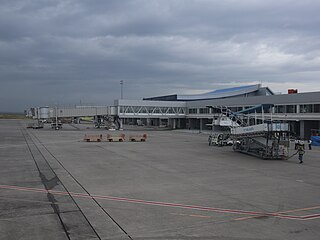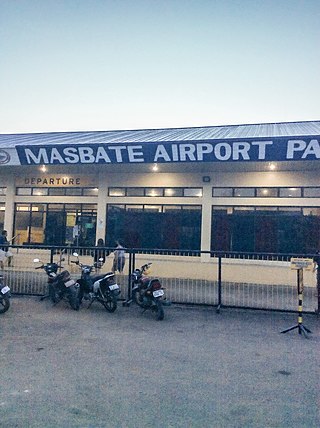Philippine Airlines (PAL) is the flag carrier of the Philippines. Headquartered at the PNB Financial Center in Pasay, the airline was founded in 1941 and is the oldest operating commercial airline in Asia.

Ninoy Aquino International Airport, also known as Manila International Airport (MIA), is the main international airport serving Metro Manila in the Philippines. Located between the cities of Pasay and Parañaque, about 7 kilometers (4.3 mi) south of Manila proper and southwest of Makati, it is the main gateway for travelers to the Philippines and serves as a hub for PAL Express and Philippine Airlines. It is also the main operating base for AirSWIFT, Cebgo, Cebu Pacific, and Philippines AirAsia.

Francisco Bangoy International Airport, also commonly known as Davao International Airport, is the main airport serving Davao City and Davao Region in the Philippines. Serving as the main gateway to Mindanao, it is the busiest airport on the island and the third busiest in the Philippines in 2022.

Zest Airways, Inc., operated as AirAsia Zest, was a Filipino low-cost airline based at Ninoy Aquino International Airport in Pasay, Metro Manila in the Philippines. It operated scheduled domestic and international tourist services, mainly feeder services linking Manila and Cebu with 24 domestic destinations in support of the trunk route operations of other airlines.

Zamboanga International Airport is the main airport serving Zamboanga City in the Philippines. Located on a 270-hectare (670-acre) site in Barangay Canelar, Zamboanga City, the airport is Mindanao's third-busiest airport after Francisco Bangoy International Airport in Davao City and Laguindingan Airport in Laguindingan, Misamis Oriental.

Dipolog Airport is the main airport serving the general area of Dipolog, the capital city of Zamboanga del Norte, in the Philippines. The airport is one of the busiest in Mindanao, especially considering its classification. It is classified as a Class 1 principal by the Civil Aviation Authority of the Philippines (CAAP), a body of the Department of Transportation (DOTr) responsible for the operations of airports in the Philippines except the major international ones.

Godofredo P. Ramos Airport, also known as Caticlan Airport and recently, Boracay Airport by its developer Trans Aire, is an airport serving the general area of the municipality of Malay, located in the province of Aklan in the Philippines. It is one of the two gateways to Boracay, the other being Kalibo International Airport in Kalibo. The airport is classified as a Class 1 principal airport by the Civil Aviation Authority of the Philippines.

General Santos International Airport, also known as Tambler Airport, is an alternate international airport located in the city of General Santos, Philippines serving the greater area of Soccsksargen. Situated in Fatima, General Santos, it is a large airport on the island of Mindanao and is officially classified as an international airport by the Civil Aviation Authority of the Philippines (CAAP), a government bureau which is responsible for the management and operations of General Santos International Airport and all other airports in the country except regular international airports.

Puerto Princesa International Airport is an airport serving the general area of Puerto Princesa, located in the province of Palawan in the Philippines. It is classified as an international airport by the Civil Aviation Authority of the Philippines.

Roxas Airport is a domestic airport serving the general area of Roxas City and the province of Capiz, in the Philippines. The airport is classified as a Class 1 principal airport, by the Civil Aviation Authority of the Philippines, a body of the Department of Transportation that is responsible for the operations of most minor and domestic airports serving various parts of the country.

Daniel Z. Romualdez Airport, also known as Tacloban City Airport, is an airport serving the general area of Tacloban, a highly urbanized city in the Leyte island of the Philippines. It is the main gateway from Manila and Cebu to Eastern Visayas. It is classified as a Class 1 principal airport by the Civil Aviation Authority of the Philippines. In 2022, Daniel Z. Romualdez Airport served 1.48 million passengers, making it the seventh-busiest in the country.

Moises R. Espinosa Airport, also known as Masbate Airport, is the airport serving the general area of Masbate City, located in the province of Masbate in the Philippines. It is named for Moises R. Espinosa Sr., a former Representative of Masbate who was assassinated at the airport on March 17, 1989.

Bicol International Airport, also referred by some sources as Southern Luzon International Airport, is an airport serving the vicinity of Legazpi, the capital city of Albay and the regional center of Bicol Region, in the Philippines.

Labo Airport, also known as Ozamiz Airport, is an airport serving the general area of the city of Ozamiz in the Philippines. It is the only airport in the province of Misamis Occidental. The airport is classified as a community airport by the Civil Aviation Authority of the Philippines, a body of the Department of Transportation that is responsible for the operations of not only this airport but also of all other airports in the Philippines except the major international airports. It is one of only two community airports in the Philippines with commercial operations, but one of the busiest in Mindanao in terms of aircraft movement and passenger traffic.

Iloilo International Airport, also known as Iloilo Airport, and as Cabatuan Airport, after the municipality of Cabatuan, Iloilo, where it is located, is the airport serving the province of Iloilo in the Philippines, including its capital city, Iloilo City, the regional center of the Western Visayas region. It opened its doors to commercial traffic on June 14, 2007, after a decade of planning and construction, replacing Mandurriao Airport in Mandurriao, Iloilo City, which had been in service for over seventy years. As a result, the new airport inherited its IATA and ICAO airport codes, as well as its position as the fourth-busiest airport in the Philippines, from its predecessor. It was the fifth-busiest airport in the Philippines in 2022. It is the first airport in both Western Visayas and the island of Panay to be built to international standards, and it is also considered to be the primary gateway into the region. It is classified as an international airport by the Civil Aviation Authority of the Philippines.
Air Philippines Corporation, operating as PAL Express and formerly branded as Air Philippines and Airphil Express, is a wholly-owned subsidiary airline of Philippine Airlines. It is PAL's regional brand, with services from its hubs in Manila, Clark, Cebu, and Davao.

Bacolod–Silay International Airport, is an airport serving the general area of Metro Bacolod, located in the Western Visayas region of the Philippines.

Mactan–Cebu International Airport is an international airport serving Cebu and serves as the main gateway to the Central Visayas region in the Philippines. Located on a 797-hectare (1,970-acre) site in Lapu-Lapu City on Mactan, it is the second busiest airport in the Philippines. Opened on April 27, 1966, the airport serves as a hub for Philippine Airlines, and as an operating base for Cebu Pacific and Philippines AirAsia.
Philippine Airlines (PAL) is the flag carrier of the Philippines, operating from its base at Ninoy Aquino International Airport. PAL is the oldest airline in Asia operating under its original name, having been founded in 1941.






















